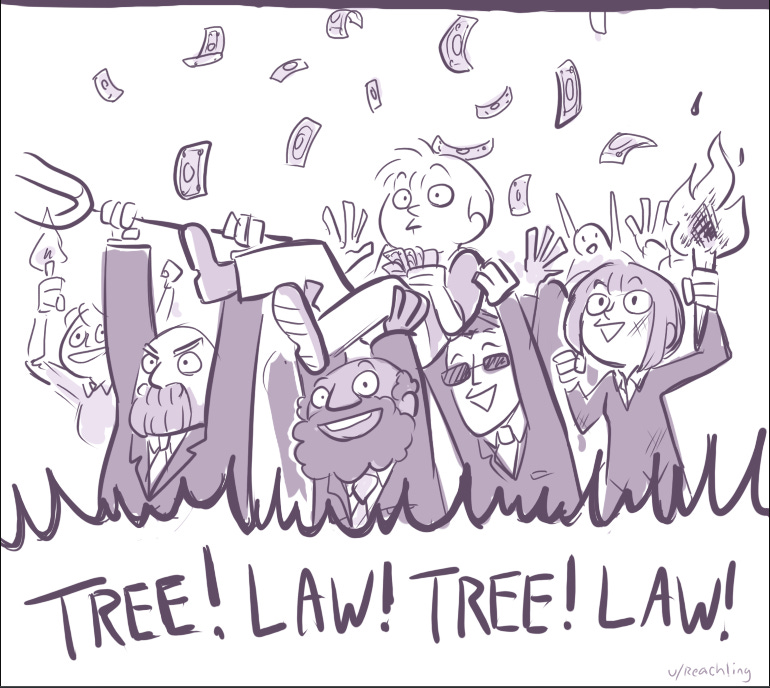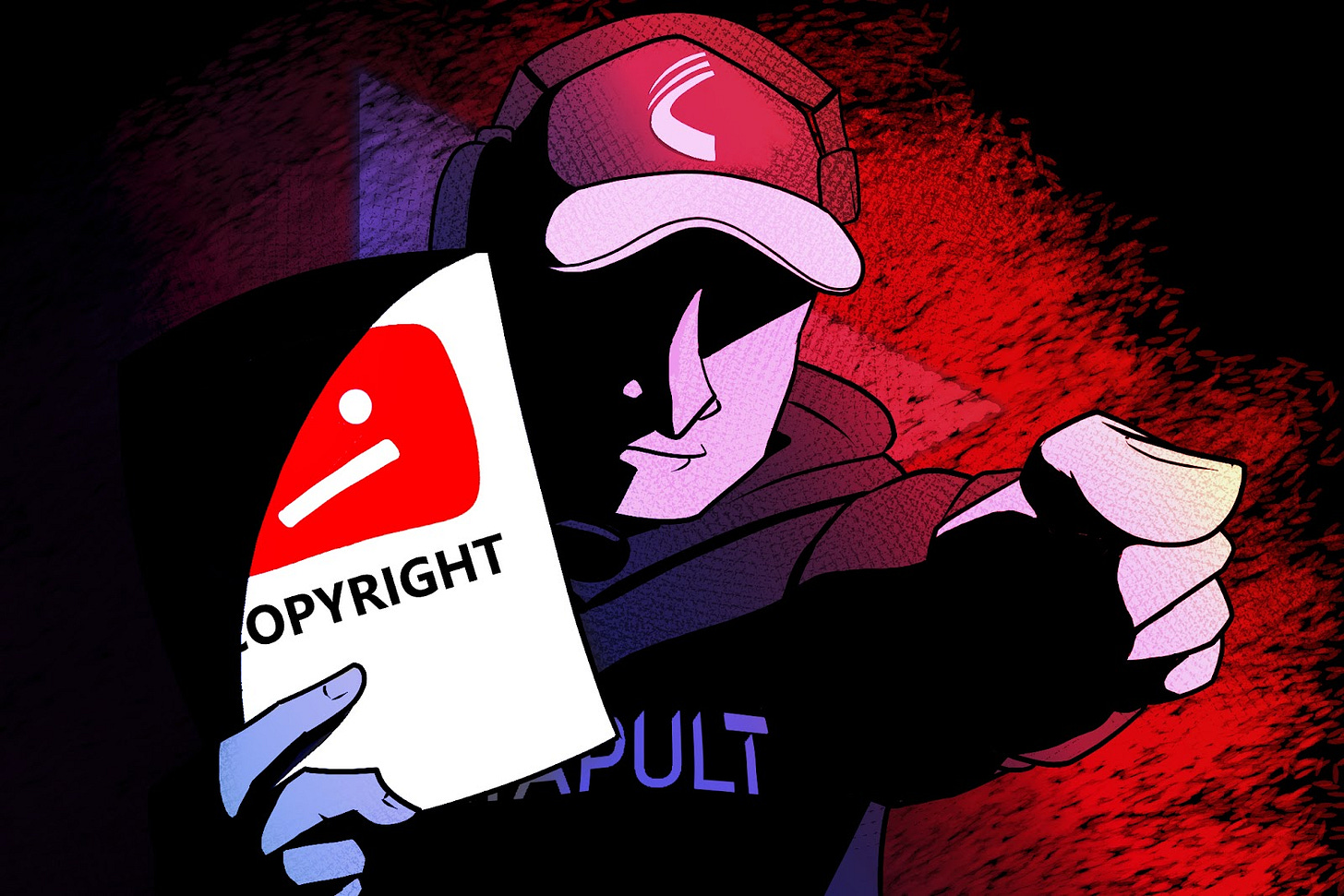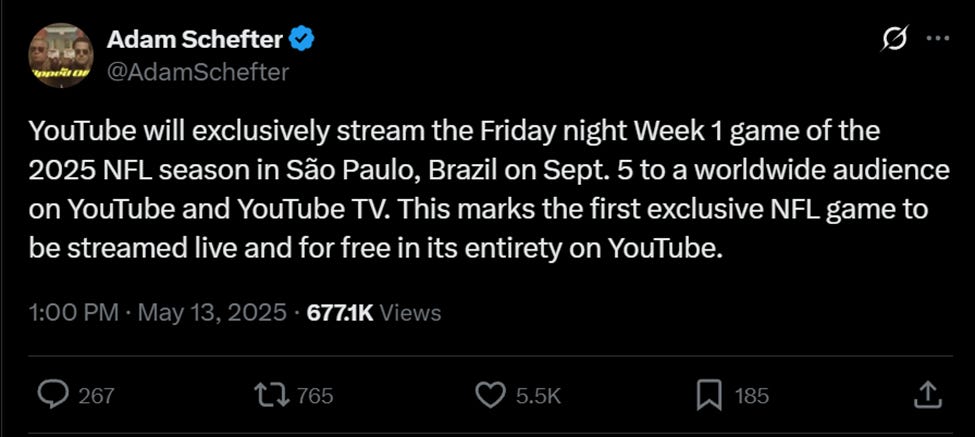How Catapult Sports is Killing Football YouTube
There's been a scourge slowly killing football analysis channels on YouTube. Unless something changes, football fans and creators will find a landscape barren of content.
On May 1, 2025, YouTuber Brett Kollmann uploaded an hour-and-a-half video detailing “The Highest Impact Picks for All 32 Teams.” In the video, he highlights key players in every NFL team’s draft class using college tape to showcase those players' traits and how they fit into their new teams’ schemes.
The video features Kollmann’s slick editing and high production value, interspersing video effects and smart transitions with the college film, all overlaid with his analysis.
On the morning of May 5, YouTuber Brett Kollmann woke up to an email that would stop most creators in their tracks.
“Hi Brett Kollmann,
After reviewing your appeal, xosdigitalsports has confirmed that your video contains copyrighted material that hasn’t been approved for use in your video.
Video title: The Highest Impact Picks for All 32 Teams
Copyrighted content: UTSA 091424 Texas OFF vs TEX UTSA O.mp4
Claimed by: xosdigitalsportsxosdigitalsports wants to give you an opportunity to cancel your appeal within the next 7 days. Canceling your appeal will return your video to the state it was in before you began this dispute.
[VIEW OPTIONS]
If no action is taken, your video will be taken down from YouTube on May 12, 2025, and a copyright strike will be applied to your account. If you still believe you have the rights to use this material, you can file a counter-notification after that date."
For most YouTube creators, copyright strikes cannot be taken lightly. Receive three strikes in a 90-day period, and your account can be terminated. For many, losing an account means a loss of livelihood. But Kollmann reacted with anger, not fear. Unlike many YouTubers, he had the means and the wherewithal to stand up to a notorious bully in the world of football content.
He decided to fight back.
This fight is about much more than the fleeting lifecycle of one YouTube video. It’s about how an antiquated copyright system, unfit for the digital age, has enabled big corporations like Catapult to exploit small content creators.
Their practices allow them to quickly and cheaply rip revenue away from people who put in hundreds of thousands of hours of work into their content. They are why fans have been denied great works of football journalism, and why football analysis hasn’t made a bigger mark on YouTube.
So, let’s step back — what exactly is so dangerous about this very dry email?
“It’s basically a scam.”
Sports on YouTube Just Aren’t Like Sports Anywhere Else
Kollmann’s is one of the biggest football YouTube channels in the landscape with more than 400,000 subscribers. Channels like UrinatingTree and FivePointsVids are in the same ballpark. The biggest sports channels usually provide quick, consumable videos. House of Highlights has 17.2 million subscribers and the official NFL channel has 14.5 million subscribers.
But those well-watched channels are dinky compared to the behemoth that is traditional sports broadcasting. The 15 most-watched broadcasts of all time in the United States are the final episode of M*A*S*H, the moon landing, Richard Nixon’s resignation speech and 12 different Super Bowls.
Football broadcasts were 76 of the 100 most-watched broadcasts in 2024. The Olympics and other sports took four more spots and 16 spots were consumed by the election. In a non-Olympic and non-election year, 2023, 93 of the 100 most-watched broadcasts were football games.
Globally, the most-watched broadcasts of all time are various FIFA World Cup games, Olympic ceremonies and the funeral of Elizabeth II.
But sports don’t crack the top videos or channels on YouTube. The most popular sports YouTube channels are vlogs from sports personalities (Cristiano Ronaldo and Celine Dept) without much sports content, while official or licensed content dominate the rest of the rankings – channels like ESPN or the NBA are at the top of the heap.
And even when counting vlogs, it’s surprising to see the most-subscribed-to sports YouTube Channel, Ronaldo’s, rank 29th among all channels. Among independent YouTubers talking about the most popular sport in the world, CazéTV is the largest with 19.2 million subscribers. That ranks about 700th worldwide.
CazéTV's sizable following isn’t that much compared to independent variety content (MrBeast’s channel is number one with 400 million subscribers), kids channels (Cocomelon ranks third at 193 million) or video game channels (PewDiePie ranks tenth with 110 million).
Music channels and channels like 5-Minute Crafts dominate the charts, as do personalities like Mark Rober, or drama channels like Alan’s Universe. One way to compare these diverse categories to each other is to look at how YouTube analytics app VidIQ categorizes content on the platform. It lists 12 categories: Autos & Vehicles, Education, Entertainment, Food, Gaming, Lifestyle, Music, News & Politics, Pets & Animals, Technology, Travel and Sports.
When looking at the top-ten creators in each category, sports channels rank fifth in subscriber count, sixth in total view count and 10th in views per video.
While it’s impossible to say exactly why sports content underperforms on YouTube compared to other mediums, it might be because the range of sports content is narrow compared to other categories.
One could compare the sports content landscape on YouTube to other types of content that rightsholders and content creators fight over. Official music channels post singles for the artists they represent and occasionally will upload full albums. Official channels for the NBA and NFL don’t even post games, choosing instead to post highlight clips on occasion.
Music reviewers often cannot play any of the actual music they review, but it’s much easier to engage with that content because it’s easy to access that music on the platform while watching someone review a song.
For football content creators who want to break down play design, highlight key moments, isolate impact players or discuss the evolution of the sport, there’s no method of depicting what they’re talking about without running afoul of a copyright system that stymies them at every turn.
In short: music listeners can actually listen to music on the platform, but sports fans can't watch sports.
Copyright and YouTube
American copyright law — I swear to God this is interesting — was not built for the digital age, with the velocity and scale of the internet in mind. Copyright law, in a manner similar to most areas of law, has been built around the notion that copyright holders could resolve their claims in court or through arbitration — processes that take time and money.
But while almost all areas of law have needed to “scale up” with the digital age, perhaps nothing has needed more tweaking for this landscape than copyright law. The expansion of digital content produced by individual creators — rather than publishers and broadcasters — has drastically changed the architecture of “intellectual property.”
There are, by several orders of magnitude, many more rightsholders and potential violations of those rights than there were 20 years ago. This isn’t really the same for land ownership law or contract law.

YouTube, in some senses, streamlines this process. Copyright holders can, through YouTube, have their claims resolved through the platform instead of through the courts. This practice gives YouTube legal protection from violations created through user-uploaded content, a concept known as Safe Harbor.
YouTube doesn’t have the option to ignore copyright concerns – that would run them afoul of several laws designed to hold platforms responsible for the content that users post – but it’s worth pointing out that they have sped up a process that was designed to take much longer.
Beyond arbitration, YouTube also offers rightsholders a means to detect infringement. From YouTube’s perspective, that makes sense; offering this service is one way to keep big copyright holders happy.
Content ID, the name of that service, scans YouTube videos and audio against a database that is constantly being updated with the property of rightsholders. The scan is designed to overcome the tricks many YouTube uploaders use to get around detection software, like reversing the content, altering the size, changing colors, slowing down or speeding up content, and so on.
This service not only insulates YouTube from the likelihood of facing future lawsuits from those copyright holders, but it also increases the odds that YouTube is able to form lucrative relationships with them.
YouTube likely wouldn't have become one of the few broadcasters allowed to exclusively stream NFL games on their platform if they weren’t committed to making rights-holders of valuable content, like the NFL, happy.
The relationships maintained by Content ID are contributing factors to YouTube’s potential to outpace Disney when it comes to showing live sports on their YouTube TV platform.
Technically, copyright holders can resolve their claims outside of YouTube, but almost none of them do. It’s more convenient to handle the process in-platform rather than through the legal system. There are other reasons to use the internal system, too.
YouTube receives an overwhelming number of claims to process. After all, over 20 million videos are uploaded every single day – an expansion from four million daily videos just a few years ago, in part because of their short-form video platform meant to challenge TikTok and Instagram Reels.
Many of those videos violate copyright, and YouTube’s broad Content ID service notifies rightsholders of potential claims nearly instantly. There is no feasible way for YouTube itself to diligently resolve millions of claims on a daily basis, so instead it relies on an automated system that essentially handles the process with minimal human interference. That’s how emails like the one Kollmann received above are generated.
The mechanism flows from the faceless procedure of automation, but it impacts real human beings, many of whom are trying to genuinely navigate the byzantine world of fair use and copyright. But, unfortunately for them, they’re fighting an uphill battle against bad actors who know how to exploit a system rigged against creators.
The Impact on Content Creators
The claim against Kollmann arrived from XOS Digital, a division of Catapult Sports. Typically, Catapult wins these disputes because few independent creators are comfortable challenging their size and financial backing.
Keep reading with a 7-day free trial
Subscribe to Wide Left to keep reading this post and get 7 days of free access to the full post archives.






